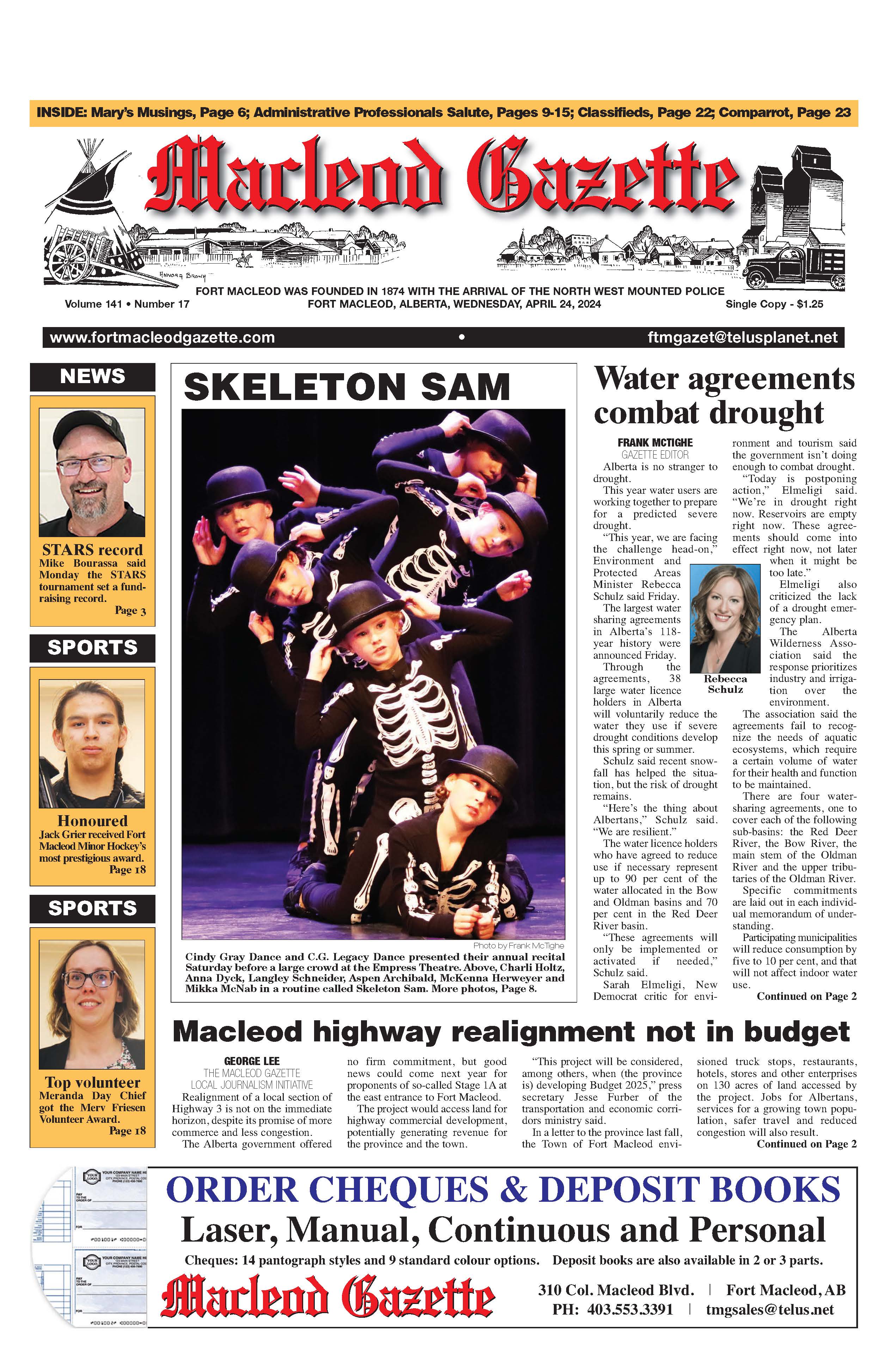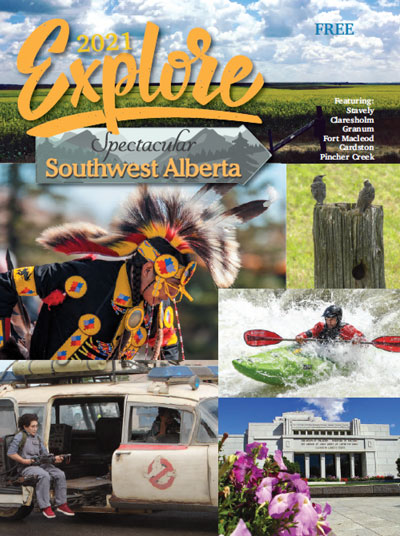Regional projects worth more than $1.7-billion for everything from highway improvements to hospital and school upgrades made the highlight reel of the Alberta government’s three-year capital spending plan, announced in the 2024 provincial budget.
In the regional funding spotlight are $231-million in projects for northern Alberta, $1.25-billion for central Alberta and $214-million for southern Alberta.
The new plan says the government will increase three-year capital funding by $2-billion to $25-billion while recognizing — in a sustainable way — what it calls the biggest surge in provincial population growth in over four decades.
Alberta’s population grew 4.1 per cent, by 184,000 people, in 2023. The budget projects it to reach five million by 2026.
“The projects underway will facilitate high-quality education and skills development, support Albertans in need, strengthen our health care system, and build roads and bridges to support economic activity and help connect people, communities and businesses,” Budget 2024 documents say. “The capital plan also continues to provide opportunities for Albertans to enjoy arts, culture, sports and recreational activities, to make Alberta a welcoming and attractive place to live, work and play.”
Capital spending is part of what Finance Minister Nate Horner called last Thursday a “responsible plan for a growing province.” The budget he tabled in the legislature projects $73.5-billion in revenue in the year 2024-’25, down $2.1-billion from the forecasted $75.6-billion for 2023-’24. Total expenses increase by about $2.8-billion over last year’s forecast, including a line item this year for a $2-billion contingency.
The budget anticipates a surplus of $367-million, making it balanced — at least in the eyes of the governing United Conservative Party. Criticism from opinion writers and the opposition questioned the government’s definition of balanced because of the projected $2.4-billion in borrowing it requires to get there.
Money that’s considered a capital investment generally goes towards buying, maintaining or improving hard assets — like buildings and equipment, and other things you can see, touch and use over and over. Operational costs are more fleeting, like fuel for machines or paper for printers, and don’t add to an organization’s asset base.
Ways to characterize the three-year capital spending pie abound in the budget, and one document pulls highlights from three regions and Alberta’s two largest cities.
Although the cities and regions geographically represent the entire province, the highlighted spending makes up just over 20 per cent of the $25-billion represented in the plan.
It isn’t always applicable to attach funding to a specific area of the province, said a spokesperson for the Ministry of Treasury Board and Finance. Of the entire three years of funding, $15.2-billion — or 61 per cent — is for province-wide projects or infrastructure initiatives, said Savannah Johannsen.
“This includes capital maintenance and renewal, information technology projects, and programs that have multiple projects throughout the province,” Johannsen said.
“Many projects span regions, such as highway projects. In addition, some capital grants haven’t been allocated, for example the new Local Growth and Sustainability Grant program.”
For 2024-’25, the government has budgeted capital spending at $8.3-billion. The figure represents a mix of new or additional funding for previously announced projects, new funding for entirely new projects, and previously announced funding for projects that are ongoing, Johannsen said.
“About $3-billion over three years is newly approved funding. This includes funding for entirely new projects, but also additional funding approved since Budget 2023 for ongoing projects,” Johannsen explained.
The northern region includes the major Edmonton suburb of St. Albert and the oilsands centre of Fort McMurray. Capital plans highlighted for the region total $231-million, the biggest-ticket item being $97-million for the addition of climbing and passing lanes on a heavy-load corridor on Highway 881 between Lac La Biche County and a hamlet southeast of Fort McMurray called Anzac.
Also on the highlight list for the north are:
- • $72-million for expanding health care facilities, including the addition of a birthing centre in La Crete
- $25-million in additional funding for a hospital replacement in Beaverlodge
- $31-million to expand Ray Gibbon Drive to connect Highway 2 to Anthony Henday Drive on the west side of St. Albert
- $6-million for a new ferry and related assessments and approvals to improve access to Little Red River Cree Nation, east of High Level.
Of the highlighted regional capital projects, those in the central region are worth about $1.27-billion. Most of the total is $810-million earmarked for redevelopment and expansion of the Red Deer Regional Hospital Centre.
Other highlighted central region items are:
- • $163-million to complete an off-stream reservoir near Calgary in Springbank to store flood waters and provide protection from future flooding
- $63-million to expand and renovate the W.J. Elliott agricultural mechanics building at Olds College
- $129.5-million for Highway 11 upgrades, including $48-million in new funding to twin Highway 11 between Rocky Mountain House and Sylvan Lake
- $50-million to support the expansion of water and wastewater infrastructure in an industrial hub northeast of Edmonton
- $32-million to construct up to three new water intakes in an area overlapping part of Edmonton dubbed the Alberta Industrial Heartland
- $12.9-million to expand the Centre for Innovation in Manufacturing at Red Deer Polytechnic
- $5-million to complete a feasibility study for a new, large-scale water storage reservoir east of Red Deer near Ardley.
Southern Alberta projects on the list, worth about $214-million, are:
- • $170-million to twin Highway 3 between Taber and Burdett
- $26-million for the University of Lethbridge Rural Medical Teaching School to provide more opportunities to train doctors in smaller communities
- $18-million for southern Alberta irrigation projects not within irrigation districts, such as those on First Nations lands.
City of Calgary highlights come in at more than $1.76-billion, including $667-million for light rail transit projects, $524-million for Deerfoot Trail upgrades, and $700,000 for renal dialysis units and the relocation of kidney patient treatments.
Meanwhile in Edmonton, highlights worth nearly $1.74-billion include $887 million for light rail transit, $145-million for Yellowhead Trail intersection modifications and new collector roads, and $17-million in new funding to continue plans for a standalone Stollery Children’s Hospital.
All told, the highlighted items make up about $5.2-billion or just over 20 per cent of the three-year capital plan.
Another way to look at the three-year capital plan is by dividing it into broad spending categories.
Municipal infrastructure — three-year spending of about $7.2-billion for things like light rail transit, water and wastewater infrastructure, a new funding framework, a program for growth and sustainability, and piloting the province’s first designated industrial zone.
Funding examples include $1.6-billion for light rail transit in Calgary and Edmonton; $111-million for strategic infrastructure to “improve accessibility and movement of goods and people,” while increasing capacity and supporting economic growth, enhancing safety and efficiency, and expanding service life; economic development support for Alberta’s first Designated Industrial Zone, the Industrial Heartland, which spans parts of the City of Edmonton and four other municipalities.
Maintenance and renewal — $3.7-billion towards roads and bridges, health facilities, post-secondary facilities, government facilities and their information technology infrastructure, schools, seniors housing and other facilities, the environment and parks.
Of this total, $1.7-billion is earmarked for roads and bridges, $512-million for health facilities and $318-million for schools.
Health facilities — $3.6-billion for projects designed, among other things, to reduce surgical and emergency wait times, strengthen the emergency medical system, address mental health and addition challenges, and prepare for future needs.
Examples include $654-million for culturally appropriate Indigenous care, on and off reserves and Metis settlements; and $191-million for child and youth mental health recovery, to be combined with federal funding of $137-million.
Roads and bridges — $2.2-billion for such items as $151-million for 36 new engineering projects for future growth, and $30-million towards bridge replacement.
Schools — $2.1-billion for schools, including $1.9-billion ($681-million of it new) for planning, design or construction of 98 new and modernized schools; $123-million for collegiate and public charter schools; and $103-million for modular classrooms to meet immediate needs.
Streamlining service delivery — $1.4-billion for better Internet access, modernized health and registry information systems, and improved access to justice services.
Of the total, $37-million over three years is for a suite of projects that “will transform how Albertans access justice services across the province,” the budget says. These projects include Web site improvement, modernization of legacy systems, record digitalization and online services enhancement.
Agriculture, natural resources and business development — $1.1-billion, including $147-million to repair and upgrade canals, dams, spillways and reservoirs; $5-million to look at the feasibility of new reservoirs; and $456-million to fund the Alberta Petrochemicals Incentive Program.
Family, social supports and housing — $829-million, including $405-million ($75-million new) towards creating 13,000 affordable housing units; $130-million ($125-million new) for seniors’ lodge modernization; and $75-million ($30-million new) for Indigenous communities to build, purchase or redevelop housing.
Self-financed capital spending for schools, universities, colleges and health entities — $1.6-billion for projects funded by tuition, donations, fund-raising and other self-generated revenue.
Public Safety and Emergency Infrastructure — $533-million for initiatives such as $75-million for flood and drought mitigation, $49-million to support first responders and sheriffs with equipment and facilities; $55-million for wildfire support facilities and equipment, like beginning the process of replacing air tankers; and $10-million for non-oilsands air, water and ground water monitoring, for better response for emergencies like spills, wildfires, droughts and floods.
Jobs skills — $361-million for post-secondary projects, like $26-million for the University of Lethbridge Rural Medical Teaching School; $55-million for 1,000 new spaces at the University of Calgary for science, technology, engineering and math programs; and $13-million for a dedicated space at Red Deer Polytechnic to help businesses conduct applied research.
Arts, sports and recreation — $323-million, including $125-million for non-profit organizations to acquire, build, upgrade or redevelop facilities used by the public; $23-million for to upgrade and build trails; and $17-million supporting improvements of the Windspear Centre in Edmonton, and Arts Commons and Olympic Plaza in Calgary.
The Capital Plan includes $3.5-billion in capital grants in 2024-25, an increase of $1.1-billion from 2023-’24. Over the following two years, capital grants will average $3.7- billion annually.
For more information on Budget 2024, visit alberta.ca/budget.




